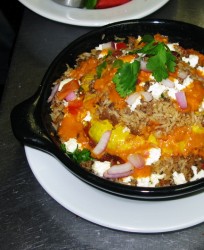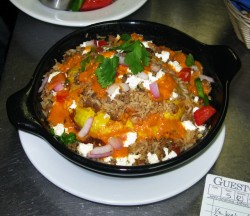Rice and Lamb Stuffed Pattypan Squash
I adore pattypan squash.
They are those round summer squashes that come in colors ranging from jade-green or cream to yellow to orange to dark green that have fluted or ridged edges and range in size from wee babies the size of a fifty-cent piece to ones that would easily fill a professional basketball player’s palm. Some of them look amusingly like UFOs–many of them are shaped like the classic 1950’s flying saucer, which always gives me a smile and a chuckle as I prepare to cook them.
What they all have in common is that they are sweet in flavor with a creamy-textured flesh that can be cooked in many different ways, all of them tasty, in my opinion. They can be roasted, sauteed, fried, grilled, and baked–just the way any other thin-skinned summer squash can, and while I love zucchini and yellow crookneck squashes plenty, I prefer the little pattypans because their flesh is firmer and less watery than that of their more familiar cousins.
What I like to do with the medium sized patty-pans–the ones that are large enough to fill my relatively large female palm, but still small in relation to a large man’s hand–is to cut off the tops, scoop out the flesh and set it aside. The shells, I then rub with olive oil and sprinkle with salt and roast lightly in the oven until they are just starting to get tender, but have not started to collapse.
Then, I concoct a stuffing, which includes the flesh of the squash, and cook it off. Then, in individual round casseroles that have been rubbed with olive oil, I place a mound of the stuffing mixture. Then, I sink one of the shells of the squash into the stuffing mound, and then fill that up with more stuffing. Cheese can go on top if you wish, or a sauce, and then, I bake the casseroles until everything is steamy-hot, with a bit of a crispy crust on the outside.
Sinking the hollowed squash shells into a mound of stuffing serves several purposes–it keeps the shell from drying out and shriveling up ior collapsing n the heat of the oven and it will also keep the squash upright and attractive while it bakes. It also gives a really hearty portion to each diner, and it allows an easy method to customize each portion as well–some people may be allergic to pine nuts or not want cheese, so those toppings can be left off easily if you are making each serving in its own dish.
In a restaurant setting, it also makes for a pretty presentation, as you can see here. This version has a filling made with leftover cooked basmati rice, onions, garlic, kalamata olives, ground lamb, tomatoes, the squash flesh, fresh basil and some already cooked stewed eggplant and zucchini. The filling was topped with feta cheese, and after each squash casserole was baked, I ladled some roasted red pepper cream sauce over it to add color and moisture.
There are so many different variations possible for this recipe–instead of rice, you could use bulgar wheat, quinoa, bread crumbs or croutons. Meat can be replaced with dried or fresh shiitake mushrooms, portabello mushrooms or plain button mushrooms. Or, you can add beans, like black beans, navy beans or pintos, or lentils, instead of meat. Or, if you like meat, but don’t like lamb, ground turkey or beef could be used in its place, or any kind of sausage, fresh or smoked, could be added to the mixture. Pancetta or bacon would also be a tasty option.
As for vegetables and aromatics–the sky is the limit. I personally love using eggplant in these stuffings because it tends to add a velvety richness and if it is grilled or roasted, a delectable smokiness that is hard to beat. Sweet peppers, roasted and skinned or diced and sauteed also add flavor and color, while tomatoes add flavor, color and a rich juiciness that is perfect with the squash. Peas can add sweetness, greens can add sweetness and a lovely texture, and fresh herbs add fragrance and flavor. I like basil, but oregano, parsley, thyme and rosemary are all lovely in this as well. Onions and garlic are a must, as far as I am concerned, but the olives could be left out or replaced with pine nuts, or any kind of nuts or capers.
As for the cheese and sauce on top–both of them are completely optional. I think that feta cheese adds wonderful flavor, but unlike many other sorts of cheese, it doesn’t melt in a creamy way, so it adds no moisture. It can be blended with chevre in order to get that creamy texture, or chevre can be used in place of it, or it can be replaced with cheddar, gouda or any other hard cheese which melts well. It all depends on the flavor profile you are trying to create.
Sauce is not necessary, but in the restaurant, it added moisture, color and an extra layer of flavor that patrons expect. I made a simple sauce of pureed roasted red pepper, harissa sauce, roasted garlic and cream with salt to taste, but an eggplant-enriched bechamel or eggplant cream would serve the same purpose. If the flavor profile is Mexican, the stuffed squash could be topped with salsa either before or after baking, if it is Italian, a marinara sauce would be great. Just match your cheese and sauce toppings to the flavors of your stuffing, and you can create your own unique version of this dish.
The possible variants of this dish are limited only by your imagination and the contents of your pantry. I’d love to see folks take my Mediterranean version and use it as a springboard for their own Turkish, Indian, Mexican, Italian, and heck–even Chinese–versions. If you do come up with a different way to make this dish, email me and I will link to your version. The more the merrier.
Rice and Lamb Stuffed Pattypan Squash
Ingredients:
4 medium to large pattypan squash
4 tablespoons olive oil
2 cups thinly sliced onions
1/2 cup finely diced red sweet bell pepper
3 tablespoons minced garlic
1 pound ground lamb
1/2 cup milk (optional)
1 teaspoon cumin
1/4 teaspoon ground cinnamon
1 tablespoon Aleppo pepper flakes
1/4 cup finely chopped kalamata olives
2 cups diced fresh tomatoes
1/2 cup leftover stewed eggplant and zucchini or roasted eggplant puree (optional)
1/2 cup fresh minced basil
1 1/2 cups cooked leftover white or brown basmati rice
salt and pepper to taste
4 ounces crumbled feta cheese
3/4 cup pureed roasted red pepper (you can use canned or jarred roasted red peppers for this)
1 head roasted garlic cloves, mashed into a puree
1/4 cup heavy cream
1 teaspoon harissa sauce, or to taste
salt and pepper to taste
minced fresh parsley and basil for garnish
finely diced red bell pepper, green bell pepper and red onion for garnish
4 basil sprigs for garnish
Method:
Preheat oven to 400 degrees F.
Cut the tops off the squashes in a thin slice. Using a melon baller, scoop out the flesh, leaving a shell of flesh about 1/4-1/2 inch thick under the skin. Set aside the interior flesh and rub the shells inside and out with one tablespoon of olive oil. Sit on a parchment-lined baking sheet and put into the oven to roast for about ten minutes or so–just until the flesh of the shells has softened. Keep on eye on the squash and do not allow it to either dry out and shrivel or go soft and collapse.
Remove squash from oven and allow to cool until you can handle it.
While the squash is cooling, heat 3 tablespoons of olive oil in a heavy-bottomed skillet. Add onions, and cook, stirring, until they turn a dark golden color. Add the garlic and cook for another minute. Crumble the raw ground lamb into the pan, and then add the milk, if you are using it. Break up the clumps of meat and cook, stirring, until the meat turns brown and the milk has boiled away. Add the spices, olives, tomatoes and the optional eggplant and zucchini, as well as the reserved squash flesh. Cook, stirring, until most of the liquid has been released by the vegetables, and everything is deliciously aromatic
Add the basil and rice, and stir to combine. Add salt and pepper to taste.
As directed above, rub individual round casseroles with olive oil, then place a mound of stuffing in each of them. Sink the squashes into the mounds, letting the stuffing rise up around the outside of the squash shells in a ring. Fill the squashes with another mound of filling, and top both the filling in the squash and the ring of it surrounding the squash with crumbles of feta cheese.
Turn the heat of the oven down to 375 degrees, and then bake the filled squashes for about fifteen minutes, or until they are hot and the cheese is melted and slightly browned and bubbly.
To make the roasted red pepper cream sauce, while the squashes are baking, put the pureed red peppers, roasted garlic, cream and harissa in a small saucepan and bring to a simmer, stirring constantly. Let the sauce reduce until it coats the back of a spoon, and flavor with salt and pepper to taste.
To serve, drizzle a ring of sauce over the ring of stuffing around the outside of the squash, and over the top of the filling. Sprinkle with the fresh herbs and the diced vegetables, and if you like, top with a sprig of fresh basil. Serve immediately.
(If you want, you can use a larger baking dish, and put a layer of filling in it. Then, sink the squash into the bed of filling, and continue as directed. When you put all of the squashes in one casserole dish, it will have to bake slightly longer–probably twenty to twenty-five minutes, instead of fifteen, and you will probably need to use more cheese–six ounces instead of four should be fine.)
2 Comments
RSS feed for comments on this post.
Sorry, the comment form is closed at this time.
Powered by WordPress. Graphics by Zak Kramer.
Design update by Daniel Trout.
Entries and comments feeds.





Wow, this sounds like what Alton Brown would call “refrigerator velcro,” and those sorts of recipes are always good to have in mind.
I’m bookmarking this and will be on the lookout for pattypans next time I’m at the farmer’s market. 🙂
Comment by Neohippie — August 27, 2008 #
Barbara- I love your site and have been a loyal reader since I found your awesome entry on chicken stock from scratch. Imagine my delight when our local DC farmer’s market had pattypans yesterday! Your site is always the first place I come to put a meal plan together. Thanks for all your wonderful posts.
Comment by Cassandra — August 28, 2008 #